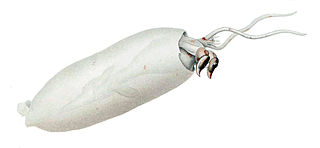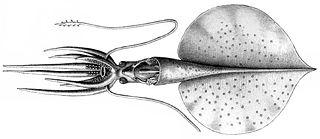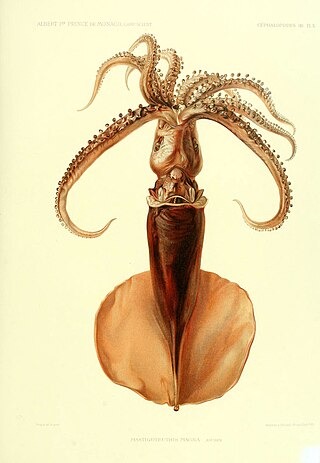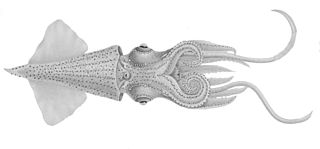
The Mastigoteuthidae, also known as whip-lash squid, are a family of small deep-sea squid. Approximately 20 known species in six genera are represented, with members found in both the mesopelagic and bathypelagic zone of most oceans. Originally described by Verill in 1881, it was later lowered by Chun (1920) to a subfamily (Mastigoteuthinae) of the Chiroteuthidae. However, Roper et al. (1969) raised it back to the family level, and this has not been changed since. The taxonomy of this family is extremely unstable, and there have been at times one genus, two genera and four subgenera(Salcedo-Vargas & Okutani, 1994), two genera and several 'groups', five genera and one species with an uncertain placement, or six genera.

Lepidoteuthis grimaldii, also known as the Grimaldi scaled squid, is a large squid growing to 1 m in mantle length. It is named after the Grimaldi family, reigning house of Monaco. Prince Albert I of Monaco was an amateur teuthologist who pioneered the study of deep sea squids by collecting the 'precious regurgitations' of sperm whales. The Grimaldi scaled squid was first collected from the stomach contents of a sperm whale. It is a widely distributed species in tropical and subtropical areas of the North and South Atlantic, the southern Indian Ocean and the Pacific Ocean, where it has been recorded off Japan and in the west Pacific.
Egea inermis is a species of glass squid in the monotypic genus Egea.

Sandalops melancholicus, the sandal-eyed squid or melancholy cranch squid, is a small species of glass squid. It is known to reach a mantle length of 11 cm (4.3 in). It is distributed in the tropical and subtropical oceans around the world. It is the only species in the genus Sandalops but some authorities suggest that this may be a species complex rather than a monotypic genus.

Taningia danae, the Dana octopus squid, is a species of squid in the family Octopoteuthidae. It is one of the largest known squid species, reaching a mantle length of 1.7 m (5.6 ft) and total length of 2.3 m (7.5 ft). The largest known specimen, a mature female, weighed 161.4 kg (356 lb).

Magnapinna talismani is a species of bigfin squid known only from a single damaged specimen. It is characterised by small white nodules present on the ventral surface of its fins.

Idioteuthis cordiformis is a species of whip-lash squid found in tropical regions of the west Pacific Ocean. The species is commonly known as the 'love-heart squid' because the species name cordiformis is Latin for 'heart shaped'. Recently, this species has been found to consume small birdbeak dogfish.
Echinoteuthis danae is a species of whip-lash squid. Known only from specimens of paralarvae, the species may be the juvenile form of Echinoteuthis atlantica.
Mastigoteuthis is a genus of whip-lash squid containing at least seven valid species. Some teuthologists consider Idioteuthis synonymous with this taxon.
Echinoteuthis is a genus of whip-lash squid containing approximately three to five species. Some teuthologists consider Idioteuthis synonymous with this taxon.

Mastigoteuthis agassizii is a species of whip-lash squid. It is the type species of the genus.
Mastigoteuthis dentata is a species of whip-lash squid.

Mastigoteuthis glaukopis is a species of whip-lash squid.

Mastigoteuthis grimaldii is a species of whip-lash squid.

Mastigoteuthis magna is a species of whip-lash squid, characterised by a lack of photophores. The skin is heavily pigmented a deep red by a numerous chromatophores.
Mastigoteuthis psychrophila is a species of whip-lash squid. It was first described by Kir Nazimovich Nesis in 1977, based on four individuals found in Antarctic waters. The largest was 143 mm long. The squid's tentacles are 15 mm in diameter, with 0.15 mm diameter club suckers. Integumental photophores are present upon the head, arms and fins. Although uncertain, it is believed to have more than two series of photophores on the arms, differing from other species in the M. agassizii group. However, this species, like the rest of the family, is badly in need of revision.

The neon flying squid, sometimes called the red flying squid, akaika, and red squid is a species of large flying squid in the family Ommastrephidae. They are found in subtropical and temperate oceanic waters globally.

Cephalopods exhibit various dermal structures on their mantles and other parts. These may take the form of conspicuous warts, cushions, papillae or scales, though in many species they are microscopic tubercles. The most elaborate forms are found among the oceanic squid of the order Teuthida.

Taonius belone is a glass squid belonging to the genus Taonius from the family Cranchiidae. It occurs in the northern subtropical and in the tropical or equatorial waters of the Pacific Ocean and the Indian Ocean.

Enoploteuthis leptura, the hooked enope squid, is a species of squid from the family Enoploteuthidae. It is the type species of the genus Enoploteuthis, which is in turn the type genus of the Enoploteuthidae.

















